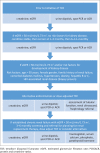An overview of tenofovir and renal disease for the HIV-treating clinician
- PMID: 30167339
- PMCID: PMC6111387
- DOI: 10.4102/sajhivmed.v19i1.817
An overview of tenofovir and renal disease for the HIV-treating clinician
Abstract
Tenofovir disoproxil fumarate (TDF, commonly termed 'tenofovir') is the antiretroviral most commonly implicated in antiretroviral-induced nephrotoxicity. As patients on successful antiretroviral therapy (ART) age, their risk for developing renal disease may increase in part because of ART itself, but more importantly, because of HIV-associated and non-HIV-associated comorbidity. Therefore, clinicians need an approach to managing renal disease in people on TDF. TDF as a cause of acute kidney injury (AKI) or chronic kidney disease (CKD) is uncommon, and clinicians should actively exclude other causes (Box 1). In TDF-associated AKI, TDF should be interrupted in all cases, and replaced, or ART interrupted altogether. Tenofovir disoproxil fumarate toxicity can present as AKI or CKD, and as a full or partial Fanconi's syndrome. TDF has a small but definite negative impact on kidney function (up to a 10% decrease in glomerular filtration rate [GFR]). This occurs because of altered tubular function in those exposed to TDF for treatment and as pre-exposure prophylaxis. Renal function should be assessed using creatinine-based estimated GFR at the time of initiation of TDF, if ART is changed, at 1-3 months, and then ideally every 6-12 months if stable. Specific tests of tubular function are not routinely recommended; in the case of clinical concern, a spot protein or albumin: creatinine ratio is preferable, but in resource-limited settings, urine dipstick can be used. More frequent monitoring may be required in those with established CKD (estimated glomerular filtration rate [eGFR] < 50 mL/min/1.73 m2) or risk factors for kidney disease. The most common risk factors are comorbid hypertension, diabetes, HIV-associated kidney disease, hepatitis B or C co-infection, and TDF in combination with a ritonavir-boosted protease inhibitor. Management of these comorbid conditions must be prioritised in this group. If baseline screening eGFR is < 50 mL/min/1.73 m2, abacavir (the preferred option), and dose-adjusted TDF (useful if concomitant hepatitis B), zidovudine or stavudine (d4T) remain alternatives to full-dose TDF. If there is a rapid decline in kidney function (eGFR drops by more than 25% and decreases to < 50 mL/min/1.73 m2 from of baseline function), or there is new onset or worsening of proteinuria or albuminuria, clinicians should review ART and other potentially nephrotoxic medications and comorbidity and conduct further testing if indicated. If kidney function does not improve after addressing reversible causes of renal failure, then referral to a nephrologist is appropriate. In the case of severe CKD, timeous referral for planning for renal replacement therapy is recommended. Tenofovir alafenamide, a prodrug of tenofovir, appears to have less renal toxicity and is likely to replace TDF in future.
Conflict of interest statement
The authors declare no potential conflict of interest.
Figures
References
-
- GBD 2016 Risk Factors Collaborators Global, regional, and national comparative risk assessment of 84 behavioural, environmental and occupational, and metabolic risks or clusters of risks, 1990–2016: A systematic analysis for the Global Burden of Disease Study 2016. Lancet. 2017;390(10100):1345–1422. 10.1016/S0140-6736(17)32366-8 - DOI - PMC - PubMed
LinkOut - more resources
Full Text Sources
Other Literature Sources
Research Materials
Miscellaneous


